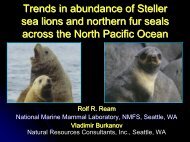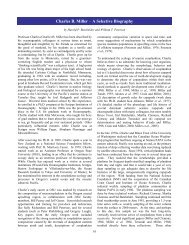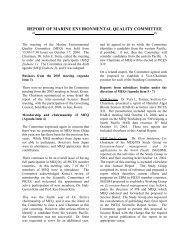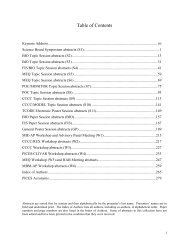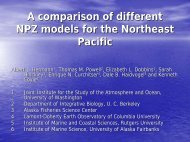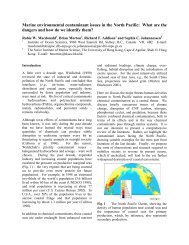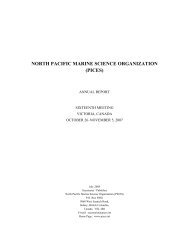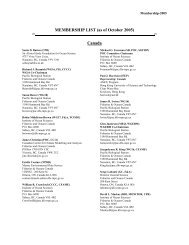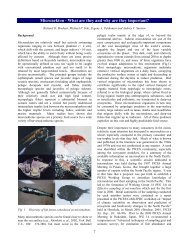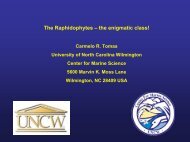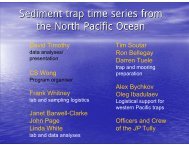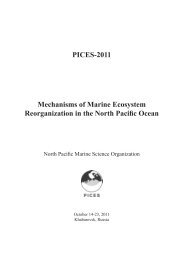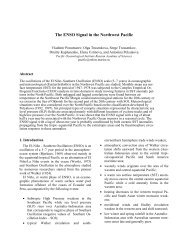R. Bruce MacFarlane, Steven Ralston, Chantell Royer and ... - PICES
R. Bruce MacFarlane, Steven Ralston, Chantell Royer and ... - PICES
R. Bruce MacFarlane, Steven Ralston, Chantell Royer and ... - PICES
Create successful ePaper yourself
Turn your PDF publications into a flip-book with our unique Google optimized e-Paper software.
hypothesize that increased food supply was more<br />
than offset by increased sockeye abundance,<br />
which resulted in greater competition <strong>and</strong> smaller<br />
body size in recent years.<br />
Acknowledgments<br />
We are extremely grateful to the numerous<br />
biologists <strong>and</strong> technicians in various management<br />
agencies who gathered, processed, <strong>and</strong> provided<br />
the time series of data analyzed here. Funding was<br />
provided by a grant to R.M. Peterman from the<br />
Natural Sciences <strong>and</strong> Engineering Research<br />
Council of Canada.<br />
References<br />
Brodeur, R.D., <strong>and</strong> Ware, D.M. 1992. Long-term<br />
variability in zooplankton biomass in the<br />
subarctic Pacific Ocean. Fisheries Oceanog.<br />
1: 32-38.<br />
Brodeur, R.D., <strong>and</strong> Ware, D.M. 1995. Interdecadal<br />
variability in distribution <strong>and</strong> catch<br />
rates of epipelagic nekton in the Northeast<br />
Pacific ocean. In R.J. Beamish (Ed.) Climate<br />
change <strong>and</strong> northern fish populations. Can.<br />
Spec. Publ. Fish. Aquat. Sci. 121, pp. 329-356.<br />
French, R., Bilton, H., Osaka, M., <strong>and</strong> Hartt, A.<br />
1976. Distribution <strong>and</strong> origin of sockeye<br />
salmon (Oncorhynchus nerka) in offshore<br />
waters of the North Pacific Ocean. INPFC<br />
Bulletin 34.<br />
McKinnell, S. 1995. Age-specific effects of<br />
sockeye abundance on adult body size of<br />
selected British Columbia sockeye stocks.<br />
Can. J. Fish. Aquat. Sci. 52: 1050-1063.<br />
Mueter, F.J., Pyper, B.J., <strong>and</strong> Peterman, R.M.<br />
2001. Effects of coastal sea surface<br />
temperatures on survival rates of sockeye,<br />
pink, <strong>and</strong> chum salmon stocks from<br />
Washington, British Columbia, <strong>and</strong> Alaska.<br />
Poster #S11-203 in Session S11: "Results of<br />
GLOBEC <strong>and</strong> GLOBEC-like programs," at<br />
the <strong>PICES</strong> Tenth Annual Meeting, Victoria,<br />
B.C., October, 5-13, 2001.<br />
Peterman, R.M., Pyper, B.J., Lapointe, M.F.,<br />
Adkison, M.D., <strong>and</strong> Walters, C.J. 1998.<br />
Patterns of covariation in survival rates of<br />
British Columbia <strong>and</strong> Alaskan sockeye<br />
salmon (Oncorhynchus nerka) stocks. Can. J.<br />
Fish. Aquat. Sci. 55: 2503-2517.<br />
Pyper, B.J., <strong>and</strong> Peterman, R.M. 1998.<br />
Comparison of methods to account for<br />
autocorrelation in correlation analyses of fish<br />
data. Can. J. Fish. Aquat. Sci. 55: 2127-2140<br />
plus the erratum printed in Can. J. Fish.<br />
Aquat. Sci. 55: 2710.<br />
Pyper, B.J., <strong>and</strong> Peterman, R.M. 1999.<br />
Relationship among adult body length,<br />
abundance, <strong>and</strong> ocean temperature for British<br />
Columbia <strong>and</strong> Alaska sockeye salmon, 1967-<br />
1997. Can. J. Fish. Aquat. Sci. 56: 1716-1720.<br />
Rogers, D.E., <strong>and</strong> Ruggerone, G.T. 1993. Factors<br />
affecting marine growth of Bristol Bay<br />
sockeye salmon. Fisheries Research 18: 89-<br />
103.<br />
Pyper, B.J., Peterman, R.M., Lapointe, M.F., <strong>and</strong><br />
Walters, C.J. 1999. Patterns of covariation in<br />
length <strong>and</strong> age at maturity of British Columbia<br />
<strong>and</strong> Alaska sockeye salmon (Oncorhynchus<br />
nerka) stocks. Can. J. Fish. Aquat. Sci. 56:<br />
1046-1057.<br />
Influences of the 1997-1998 El Niño <strong>and</strong> 1999 La Niña on juvenile chinook<br />
salmon in the Gulf of the Farallones<br />
R. <strong>Bruce</strong> <strong>MacFarlane</strong>, <strong>Steven</strong> <strong>Ralston</strong>, <strong>Chantell</strong> <strong>Royer</strong>, <strong>and</strong> Elizabeth C. Norton<br />
NOAA Fisheries, Southwest Fisheries Science Center, Santa Cruz Laboratory, 110 Shaffer Road, Santa<br />
Cruz, CA 95060, U.S.A. E-mail: <strong>Bruce</strong>.<strong>MacFarlane</strong>@noaa.gov<br />
El Niño, the warm phase of El Niño/Southern<br />
Oscillation (ENSO) events, has been shown to<br />
produce dramatic effects on marine communities.<br />
Alterations in physical oceanographic properties<br />
of the marine environment can be observed as far<br />
north as Alaska. Less is known of the influences<br />
of La Niña, the cool phase of ENSO events that<br />
follows an El Niño. During the 1982-83 El Niño,<br />
anomalous plankton distributions, altered fish<br />
community structure, <strong>and</strong> reduced fish catch<br />
25
occurred in coastal waters of southern California<br />
(Simpson, 1992). Along the central California<br />
coast, the 1992-93 El Niño corresponded to<br />
delayed phytoplankton blooms, changes in the<br />
abundance <strong>and</strong> distribution of invertebrates,<br />
improved recruitment of southern fish species, but<br />
recruitment failure in the northerly rockfish<br />
species (Lenarz et al. 1995). More recently, the<br />
largest decline in macrozooplankton abundance<br />
off central <strong>and</strong> southern California in the 50-year<br />
series of CalCOFI cruises was recorded during the<br />
1997-98 El Niño (Lynn et al. 1998).<br />
In addition to ecosystem impacts, changes in<br />
physiology <strong>and</strong> behavior of fishes, including<br />
salmon, have been noted during ENSO events.<br />
Poor growth <strong>and</strong> low condition, ascribed to low<br />
fat content, were found in adult rockfish off<br />
central California during 1992-93 (Lenarz et al.<br />
1995). And in a study of widow (Sebastes<br />
entomelas) <strong>and</strong> yellowtail rockfish (S. flavidus) in<br />
coastal waters of central <strong>and</strong> northern California,<br />
Woodbury (1999) reported reduced otolith<br />
growth, a conservative measure of somatic growth<br />
history, during the 1982-83 El Niño. Reduced<br />
condition <strong>and</strong> growth of sockeye salmon<br />
(Oncorhynchus nerka) in the Gulf of Alaska<br />
during the 1997-98 El Niño event were related to<br />
feeding on zooplankton, prey of lower caloric<br />
content than squid, their primary food in 1998<br />
following the El Niño (Kaeriyama et al. 2000). In<br />
a review of El Niño effects on fisheries, Mysak<br />
(1986) detailed other impacts to sockeye,<br />
including changes in migration patterns <strong>and</strong> the<br />
timing of returns to streams. Lower survival in<br />
juvenile coho salmon (O. kisutch) following ocean<br />
entry, great mortality in adult coho, <strong>and</strong> reduced<br />
size in both coho <strong>and</strong> chinook salmon (O.<br />
tshawytscha) were described off Oregon during<br />
the 1982-83 El Niño (Pearcy <strong>and</strong> Schoener 1987).<br />
We report here the results of a study of juvenile<br />
chinook salmon in the Gulf of the Farallones, an<br />
embayment on the central California coast. The<br />
Gulf of the Farallones, a broad expanse of<br />
continental shelf extending from Pt. Reyes to<br />
Pillar Pt. out to the Farallon Isl<strong>and</strong>s, receives<br />
freshwater outflow through the Golden Gate from<br />
the Sacramento <strong>and</strong> San Joaquin Rivers <strong>and</strong> their<br />
tributaries in California’s Central Valley. It is<br />
also the point of ocean entry for an estimated 50-<br />
60 million chinook salmon smolts spawned from<br />
four runs (fall, late fall, winter, spring) in streams<br />
<strong>and</strong> hatcheries in the Central Valley. The purpose<br />
of the information presented here is to document<br />
juvenile salmon development, <strong>and</strong> how it was<br />
influenced by the environment in the Gulf of the<br />
Farallones during the 1997-98 El Niño <strong>and</strong> 1999<br />
La Niña.<br />
Juvenile salmon were captured by surface trawl at<br />
locations in the Gulf of the Farallones in June to<br />
October of 1998 <strong>and</strong> 1999. El Niño was evident<br />
in the Gulf of the Farallones in August 1997 <strong>and</strong><br />
persisted to August 1998 (Fig. 3). By late 1998,<br />
La Niña was apparent <strong>and</strong> continued into spring<br />
2000. Plankton samples were taken by Tucker<br />
Trawl at 5 m <strong>and</strong> 15-25 m below the surface to<br />
estimate secondary productivity <strong>and</strong> zooplankton<br />
composition.<br />
Relative growth for juveniles caught in 1998 <strong>and</strong><br />
1999 was estimated by microstructural analysis of<br />
otoliths. Growth rates <strong>and</strong> size-at-age of juvenile<br />
chinook salmon can be estimated by measuring<br />
daily otolith increment widths (Bradford <strong>and</strong> Geen<br />
1987). We calculated mean otolith increment<br />
widths as an index for somatic growth between<br />
increments 160 <strong>and</strong> 260, representing the first 100<br />
days after leaving the estuary. Juvenile salmon<br />
exited San Francisco Estuary at 160±1 days old in<br />
1998 <strong>and</strong> at 168±3 days old in 1999. Growth rate<br />
indices for salmon caught in 1998, during the El<br />
Niño period, were significantly greater than for<br />
fish collected in 1999 (P
5.00<br />
4.00<br />
3.00<br />
NOAA Weather Buoys<br />
Bodega Bay (1981-96)<br />
Halfmoon Bay (1980-96)<br />
San Francisco (1982-96)<br />
SST Anomaly ( o C)<br />
2.00<br />
1.00<br />
0.00<br />
-1.00<br />
-2.00<br />
-3.00<br />
-4.00<br />
J F M AM J J A S O NDJFMAMJJASO NDJ FM AMJ JA<br />
1997 1998 1999<br />
Fig. 3 Sea surface temperature anomalies from buoys at Bodega Bay, San Francisco, <strong>and</strong> Half Moon<br />
Bay. Anomalies were calculated from longer-term averages shown in parentheses in the legend. All<br />
three buoys were out of operation from December 1997 to mid-March 1998 when El Niño conditions<br />
were most evident.<br />
4.5<br />
Mean Increment Width (um)<br />
4<br />
3.5<br />
3<br />
2.5<br />
1999<br />
1998<br />
2<br />
150 160 170 180 190 200 210 220 230 240 250 260 270<br />
Increment # (days)<br />
Fig. 4 Mean otolith increment widths for juvenile chinook salmon from the Gulf of the Farallones in<br />
1998 (solid circles) <strong>and</strong> 1999 (open triangles). Lines represent least squares fit of daily mean increment<br />
widths; solid line - 1998, dashed line - 1999. Vertical dashed lines at 160 <strong>and</strong> 260 increments represent<br />
estimated first 100 days in the ocean after leaving the San Francisco Estuary.<br />
27
concentrations in juvenile salmon after exiting the<br />
estuary (<strong>MacFarlane</strong> <strong>and</strong> Norton, 2002).<br />
Juvenile salmon in the Gulf of the Farallones not<br />
only grew faster <strong>and</strong> maintained a greater TAG<br />
concentration during the 1998 El Niño period,<br />
their condition (Fulton’s K-factor) was better as<br />
well. In 1998, mean K increased to 1.42±0.01 for<br />
gulf salmon from 1.03±0.01 at ocean entry,<br />
compared with a change from 1.04±0.01 at ocean<br />
entry to 1.32±0.01 in the gulf during 1999.<br />
Although there were differences in growth, energy<br />
status, <strong>and</strong> condition between the two years,<br />
feeding data did not resolve the disparity. This is<br />
not unexpected because stomach contents reflect<br />
only recent feeding, whereas growth <strong>and</strong> lipid<br />
accumulation integrate metabolic processes over<br />
longer time scales. Stomach fullness was<br />
estimated to be 45.5% in juveniles sampled in<br />
1998 <strong>and</strong> 56.7% in 1999. In both years, fish were<br />
the primary food item, comprising greater than<br />
50% of the stomach contents volume. Decapod<br />
early life stages were of secondary importance,<br />
especially for salmon later in the season in August<br />
to October.<br />
The marine environment in the Gulf of the<br />
Farallones differed between the two years. From<br />
May through August, mean sea surface<br />
temperatures were about 1.0°C warmer in 1998<br />
<strong>and</strong> about 1.3°C cooler in 1999 than long-term<br />
averages (Fig. 3). The 1997-98 El Niño was<br />
characterized by heavy precipitation in California<br />
<strong>and</strong> this was evident in freshwater outflow from<br />
the Central Valley. Freshwater outflow into the<br />
gulf averaged 2,940 cubic meters per sec (m 3 /s)<br />
from January to June 1998, whereas outflow in<br />
1999 was much reduced during the dryer La Niña<br />
to 1,330 m 3 /s.<br />
The Gulf of the Farallones is buffered from largescale<br />
oceanic influences because it is in the<br />
upwelling shadow of Pt. Reyes to the north,<br />
bounded by the Farallon Isl<strong>and</strong>s <strong>and</strong> associated<br />
marine banks on the west, <strong>and</strong> subjected to the<br />
effects of freshwater outflow from San Francisco<br />
Bay. Although El Niño typically produces<br />
enhanced poleward flow of the California Current,<br />
near-surface current data from an Acoustic<br />
Doppler Current Profiler in May <strong>and</strong> June 1998<br />
did not reveal such a pattern. Currents in the gulf<br />
were forced by tidal circulation <strong>and</strong> persistent<br />
northwesterly winds, which also produced positive<br />
upwelling index anomalies throughout the summer<br />
<strong>and</strong> fall of 1998 (April - November mean monthly<br />
anomaly for 39°N 125°W: +44.5±25.6). As<br />
expected, strong northwesterly winds during the<br />
summer <strong>and</strong> fall of the 1999 La Niña event<br />
resulted in intense upwelling with a mean April to<br />
November monthly index anomaly of 104.6±35.1.<br />
Biological productivity is highly variable in the<br />
Gulf of the Farallones region <strong>and</strong> modulated to<br />
varying degrees by upwelling, advection, winddriven<br />
<strong>and</strong> tidal circulation, <strong>and</strong> freshwater<br />
outflow. Primary productivity, estimated by<br />
chlorophyll a concentrations in May <strong>and</strong> June, was<br />
similar between the two years, but the distribution<br />
of phytoplankton differed. In 1998, phytoplankton<br />
were distributed within the gulf on the continental<br />
shelf whereas during the 1999 La Niña they were<br />
primarily off the shelf, seaward of the gulf.<br />
Greater nutrient-rich freshwater influx coupled<br />
with higher temperatures in 1998 may have<br />
accounted for greater primary productivity within<br />
the gulf during the El Niño event. Greater<br />
phytoplankton biomass within the Gulf of the<br />
Farallones in 1998 was accompanied by greater<br />
secondary production. Mean zooplankton biomass<br />
in the near-surface waters was 0.30±0.12 ml/m 3 in<br />
May <strong>and</strong> September 1998. In contrast,<br />
zooplankton mean settled volume was 0.13±0.03<br />
ml/m 3 in August <strong>and</strong> October 1999.<br />
In summary, during the 1997-98 El Niño, juvenile<br />
salmon in the Gulf of the Farallones grew at a<br />
greater rate, maintained higher TAG reserves, <strong>and</strong><br />
were in better condition than those during the 1999<br />
La Niña. This profile may be attributed to<br />
somewhat higher biological productivity in the<br />
gulf in 1998, due to increased nutrient input from<br />
freshwater inflow, <strong>and</strong> the protection afforded by<br />
Pt. Reyes <strong>and</strong> the Farallon Isl<strong>and</strong>s, which buffered<br />
the embayment from the full impacts of oceanic<br />
processes. But, for all measures of salmon<br />
development the differences were not great. The<br />
data do support the contention, however, that the<br />
1997-98 El Niño was not detrimental to juvenile<br />
chinook salmon development in this region during<br />
the early stage of the ocean phase of their life<br />
cycle.<br />
28
References<br />
Bradford, M.J., <strong>and</strong> Geen, G.H. 1987. Size <strong>and</strong><br />
growth of juvenile chinook salmon backcalculated<br />
from otolith growth increments, p.<br />
453-461. In R.C. Summerfeldt <strong>and</strong> G.E. Hall<br />
[eds.] The age <strong>and</strong> growth of fish. Iowa State<br />
University Press, Ames, IA.<br />
Kaeriyama, M., Nakamura, M., Ueda, H., Anma,<br />
G., Takagi, S., Aydin, K.Y., Walker, R.V., <strong>and</strong><br />
Myers, K.W. 2000. Feeding ecology of<br />
sockeye <strong>and</strong> pink salmon in the Gulf of<br />
Alaska. NPAFC Bulletin 2: 55-63.<br />
Lenarz, W.H., Ventresca, D.A., Graham, W.M.,<br />
Schwing, F.W., <strong>and</strong> Chavez, F. 1995.<br />
Explorations of El Niño events <strong>and</strong> associated<br />
biological population dynamics off central<br />
California. CalCOFI Report 36: 106-119.<br />
Lynn, R.J., Baumgartner, T., Garcia, J., Collins,<br />
C.A., Hayward, T.L., Hyrenbach, K.D.,<br />
Mantyla, A.W., Murphree, T., Shankle, A.,<br />
Schwing, F.B., Sakuma, K.M., <strong>and</strong> Tegner,<br />
M.J. 1998. The state of the California<br />
Current, 1997-1998: transition to El Niño<br />
conditions. CalCOFI Report 39: 25-49.<br />
<strong>MacFarlane</strong>, R.B,. <strong>and</strong> Norton, E.C. 2002.<br />
Physiological ecology of juvenile chinook<br />
salmon (Oncorhynchus tshawytscha) at the<br />
southern end of their distribution, the San<br />
Francisco Estuary <strong>and</strong> Gulf of the Farallones,<br />
California. Fishery Bulletin 100 (2) (In<br />
press).<br />
Mysak, L.A. 1986. El Niño, interannual<br />
variability <strong>and</strong> fisheries in the northeast<br />
Pacific Ocean. Can. J. Fish. Aquat. Sci. 43:<br />
464-497.<br />
Pearcy, W.G., <strong>and</strong> Schoener, A. 1987. Changes<br />
in the marine biota coincident with the 1982-<br />
1983 El Niño in the northeastern subarctic<br />
Pacific Ocean. J. Geophys. Res. 92: 14,417-<br />
14,428.<br />
Simpson, J.J. 1992. Response of the Southern<br />
California current system to the mid-latitude<br />
North Pacific coastal warming events of<br />
1982-1983 <strong>and</strong> 1940-1941. Fisheries<br />
Oceanogr. 1: 57-79.<br />
Woodbury, D. 1999. Reduction of growth in<br />
otoliths of widow <strong>and</strong> yellowtail rockfish<br />
(Sebastes entomelas <strong>and</strong> S. flavidus) during<br />
the 1983 El Niño. Fishery Bulletin 97: 680-<br />
689.<br />
Variability of the pink salmon sizes in relation with abundance of Okhotsk<br />
Sea stocks<br />
Olga S. Temnykh 1 <strong>and</strong> Sergey L. Marchenko 2<br />
1<br />
Pacific Research Fisheries Center (TINRO-center), 4, Shevchenko Alley, Vladivostok, Russia,<br />
690600. E-mail: tinro@tinro.ru<br />
2<br />
MoTINRO, Magadan, Russia. E-mail: tinro@online.magadam.su<br />
Beginning in the mid-1970s there was an increase<br />
in abundance of all Pacific salmon species. It was<br />
shown that global climatic factors may have<br />
caused changes in salmon abundance in the North<br />
Pacific (Beamish <strong>and</strong> Bouillon 1993, Klyashtorin<br />
<strong>and</strong> Sidorenkov 1996, Radchenko <strong>and</strong><br />
Rassadnikov 1997, Shuntov et al. 1997). The rise<br />
in abundance of Asian <strong>and</strong> American stocks of<br />
salmon was accompanied by a decrease in the<br />
average size of fish, by an increase in age at<br />
maturity (due to the growth rate reduction during<br />
marine period of their life cycle), <strong>and</strong> by a<br />
reduction of the fecundity of females (Ishida et al.<br />
1993, Welch <strong>and</strong> Morris 1994; Bigler at.al. 1996).<br />
Nevertheless, there are some exceptions to the<br />
general trend of Pacific salmon productivity in<br />
relation to stock abundance. For example, a<br />
decrease in abundance was observed for the<br />
Japan/East Sea pink salmon stocks (especially for<br />
the Primorye stock) while the average size of the<br />
Primorye pink salmon decreased during the 1970-<br />
1980s (Temnykh 1998). At the same time,<br />
abundant pink salmon from Sakhalin maintained a<br />
large size (Nagasawa 1998).<br />
29



